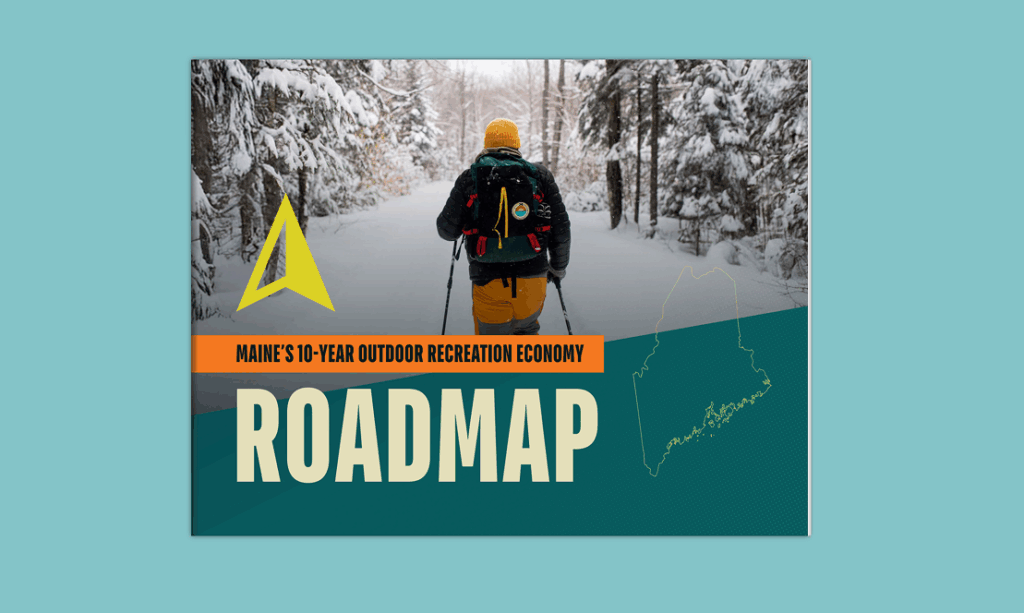A WAY FORWARD
A guide to growing and diversifying Maine’s $3.4B outdoor recreation economy over the next ten years. To find the full report and plans for accomplishing the outlined goals, you can download the Roadmap here.
WHAT IS THE OUTDOOR RECREATION ECONOMY?
Making an impact
$3.4B
in economic contribution tied to outdoor recreation, representing 3.7% of the entire state’s gross domestic product (GDP).
30,000
jobs the outdoor recreation industry supports, making
up 4.5% of statewide employment.
90+
outdoor product brands manufacture in Maine, from iconic heritage brands to groundbreaking newcomers.
A SHARED VISION FOR MAINE
The Roadmap, aligned with the visions and goals of other statewide plans and initiatives, emphasizes two essential themes: Collaboration and Assurance. By working in partnership and strategically aligning our efforts, we can preserve, enhance, and expand Maine’s assets. This unified approach enables us to not only directly confront challenges, but also foster the expansion of economic opportunities for Maine’s communities.
EXISTING OPPORTUNITIES AND CHALLENGES
To realize the vision, the Roadmap first identifies opportunities and challenges facing Maine’s outdoor recreation economy, including:
WORKFORCE
While Maine is in the top ten states for outdoor recreation economy employment, the sector struggles to attract and retain talent due to relatively low compensation, seasonality, workforce housing challenges, and a lack of awareness of career pathways, education, and training opportunities.
RURAL REVITALIZATION
Outdoor recreation can be a powerful economic development and diversification tool in rural areas. However, local municipalities and leaders need support and capacity to plan for and implement the required infrastructure.
LEGACY AND HERITAGE
Spending time recreating outdoors and being a good steward is a way of life in Maine, and long-time residents have a deep connection to and respect for the land and water that should be passed on and continued as the outdoor recreation economy grows.
MODERNIZATION AND INNOVATION
In addition to advancing new products and services that help outdoor recreation businesses adapt to economic, environmental, and social challenges, the sector needs access to supply chains, materials, and other innovations that can help businesses thrive.
ACCESS AND CONNECTIVITY
Maine’s natural beauty and diverse recreational opportunities are attracting increasing numbers of visitors, but infrastructure needs to be improved to accommodate this growth, enable quality and consistency of experiences, and ensure residents benefit from enhanced recreation assets and the economic value that comes with increased tourism.
PRIVATE LAND ACCESS
Most of Maine’s land is privately owned, and while many landowners grant public access, it can be challenging for recreationists to understand where access exists and for landowners to communicate and manage access effectively.
DIVERSIFICATION
Expanding the definition of outdoor recreation beyond traditional activities like hiking, skiing, and fishing to embrace emerging trends like ecotourism, restorative tourism, dark skies, and outdoor wellness experiences can capture broader interests, attract new people, and create a more diverse array of outdoor recreation options for visitors.
INCLUSION AND BELONGING
Creating equitable access to outdoor recreation that is welcoming to all Maine residents, regardless of background or ability, is essential for fostering a thriving and inclusive sector.
CLIMATE CHANGE
Addressing the impacts of climate change on Maine’s natural resources and adopting technologies that can reduce environmental and ecological risk and increase resiliency is crucial to ensure the long-term viability of the outdoor recreation economy.
QUALITY AND CRAFTSMANSHIP
Maine’s legacy of high-quality craftsmanship in woodworking and textiles offers a distinct advantage. However, rising manufacturing costs and a shrinking skilled workforce challenge the sector’s growth. Blending tradition with modern, sustainable practices can help preserve this heritage while meeting new market demands.
A FOCUSED MISSION
The Roadmap is guided by four main goals and supporting strategies that outdoor recreation economy leaders seek to achieve over the next ten years:
Goal 1
Elevate Maine’s outdoor recreation industry into a critical and thriving pillar of the state’s economy.
Goal 2
Increase and sustainably manage outdoor recreation.
Goal 3
Establish outdoor recreation as a tool for building vibrant, economically diverse, and resilient communities.
Goal 4
Establish Maine as a premier state for outdoor recreation businesses, education, training, and career opportunities
OVERALL MEASURES OF SUCCESS

Maine’s outdoor recreation economy will grow by 10%, matching the overall state GDP goals with a value of $3.7B by 2035.
Maine will maintain its 5% workforce employed in the outdoor recreation economy, remaining in the top ten states nationwide.
To find the full report and plans for accomplishing these goals, download the Roadmap.
